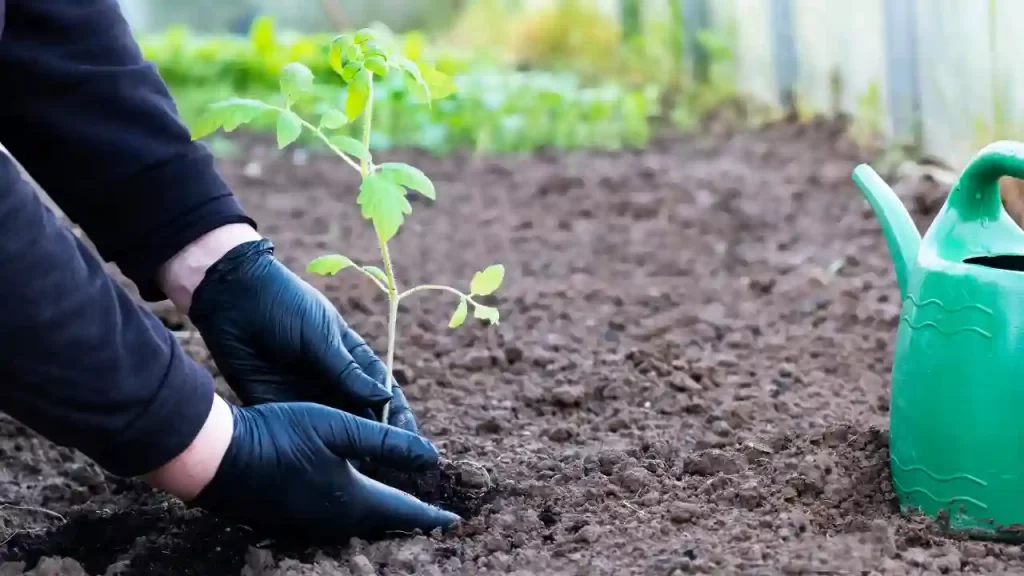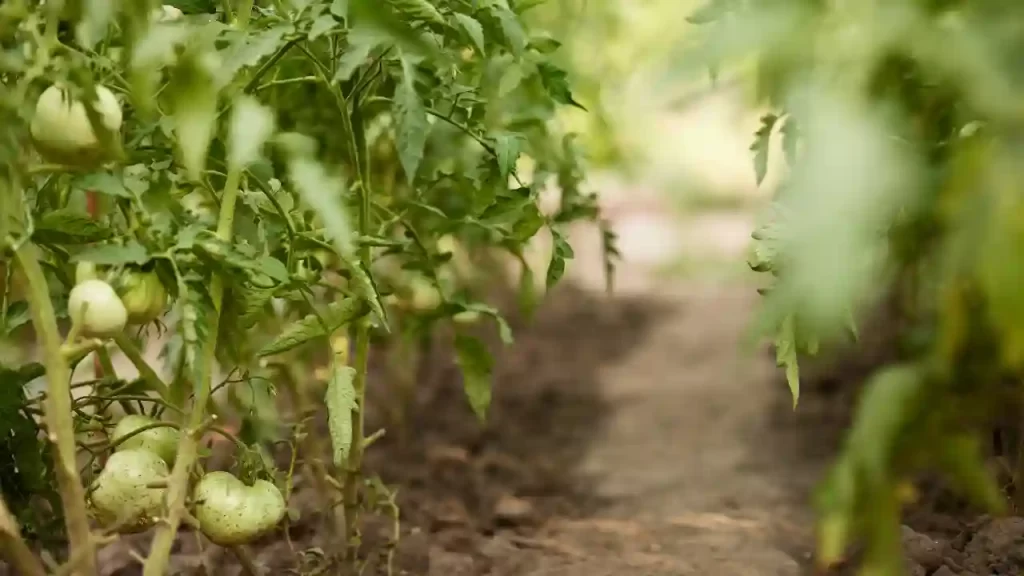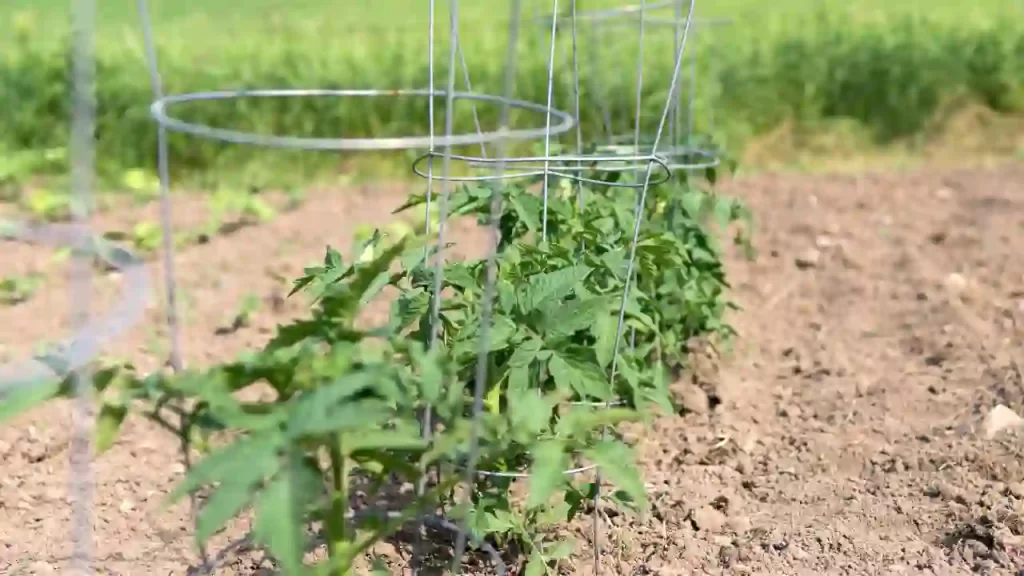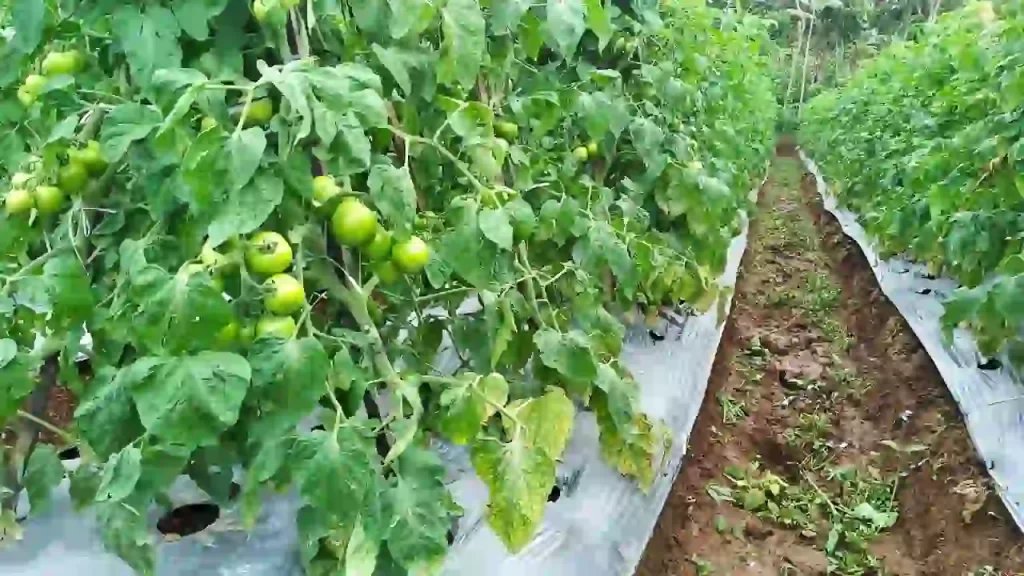If you plan to grow tomatoes, there are many things to ensure for a healthy plant, and tomato spacing is one of the important factors. Properly spaced plants can remain healthy and strong and develop a strong root system.
Even the risk of pests and diseases is also prevented with such initiative, and your tomato plant would reward you with flavorful and high-quality fresh tomatoes with a high yield.
Even with a small garden, you must be cautious regarding space between the plants.
Now the question is what should be the ideal spacing between each tomato plant. It depends on the variety of tomatoes planted and whether it has been supported with stakes or cages or left unsupported.
In this article, I have explained the ideal spacing for each type of tomato plant and how close you can space tomatoes for good yields.
Why Is Spacing Important?

Spacing plays a vital role in the overall growth and development of plants. They won’t get proper light and good airflow until an ideal spacing between the plants is maintained.
Less spacing between the tomato plants makes them more susceptible to diseases and infections, and the chances of spreading such diseases are also higher.
Because less spacing between the plants can suffocate them, soil and bottom leaves remain damp for a long time, and unfortunately, pests are more attracted to such conditions.
If the proper spacing between the plants is maintained, the plants can breathe due to good air circulation, and thus risk of pests and diseases is reduced.
Tomatoes start to compete for nutrients with their neighboring tomato plants and thus face many health issues due to lack of nutrients and become more prone to pests and infections. It also results in weaker stems which become inefficient in supporting the fruits, and thus the production of fruits is also impacted.
Maintaining 24 inches of space between the plants encourages sunlight to reach the whole plant, and photosynthesis is also performed in compact plants as well. Hence the growth and development of plants are also promoted, and in return, plants produce a high yield.
It is very difficult to monitor your plants for any pests and diseases if they are too close to each other. The harvesting process also seems difficult.
Proper spacing between the plants allows you to easily prune, harvest, and inspect for pests and diseases.
Allow Room For Companion Plants
Companion planting is always considered as one of the best ways to benefit your tomato plants. But a gardener needs to understand the importance of proper spacing between the plants to avoid any complications in the future.
Planting marigolds as a companion plant to tomatoes is the best idea. It can benefit your tomatoes in many ways and keep them healthy. It won’t need much spacing, but ideal spacing should be maintained to keep enough airflow between the plants and allow sunlight to penetrate and reach all the parts of the plants.
Factors That Influence the Spacing of Tomatoes Grown

Indeterminate vs. Determinate Tomatoes
Indeterminate varieties of tomatoes are known for the continued production of fruits and their continuous growth. While determinate varieties grow up to a certain height and bloom and set fruits once throughout the season, which means in each season, the plant can produce all fruits at the same time only.
Determinate tomatoes grow smaller and are also referred to as bush tomatoes, whereas indeterminate tomatoes are vining in nature and continue to grow and produce fruits.
Indeterminate tomatoes grow to 8 feet high and need stakes or trellis to support these plants and keep them straight. At the same time, determinate plants can grow only 3-4 feet tall.
Spacing between the plants mostly depends on the variety chosen to grow.
As indeterminate plants grow high, it requires more spacing, whereas determinate plants comparatively need less space because of their small height.
Cages or Stakes

Supporting your tomatoes encourages their health, growth, and ability to produce fruits. And you need to support your plants according to their variety.
Determinate plants grow smaller in height but bushier. So, I would recommend supporting them with wire cages.
Indeterminate plants which grow smaller can also be supported with cages. Even 2 feet of space between the plants are enough for the caged plants, and plants can grow well.
Some determinate tomato varieties like Tiny Tims can be grown in containers even without any support. But need to be necessarily supported with cages to stand straight in the soil if directly planted in the ground.
Considering any necessary requirements, I plant staked tomatoes to anywhere from 18 to 36 inches apart.
Spacing Your Tomatoes
The ideal row spacing for tomato plants is 4 feet. Tomatoes supported with stakes need more than 2 feet of row spacing between each plant.
Indeterminate tomato varieties not provided with any support need extra space, i.e., 4 feet of space per plant, as they grow widely on the vines.
Due to less growth of determinate tomatoes, less row spacing between the determinate tomato plants is needed.
2 feet of row spacing and 2 feet of space between each plant are enough for the determinate variety of tomatoes.
Providing enough row spacing encourages overall plant growth and a strong root system. As a result, plants can stay healthy and set many fruits in them.
At the stage of plantation of tomatoes, ensure to maintain 2 feet of spacing on both sides of the row. It would prevent root tangling and abandon plants to compete for nutrients.
If you have a smaller garden, go for raised bed gardening. Big plants like tomatoes perform well in raised beds gardening and with support cages. Planting in raised beds can be done as easily as in traditional beds.
Raised bed planting is very good for tomato plants as they can get enough nutrients and won’t compete with each other. Thus the health of all the plants is maintained.
Containerized tomatoes need extra outward and downward spacing for their strong and healthy root system development. Planting only one tomato plant in one container is beneficial, and the plants can thrive well. (Check our article to understand why you shouldn’t plant two or more plants in one container)
How far apart to plant tomatoes in a raised bed?

When planting tomatoes in a raised bed, the distance between each plant should be at least 18 inches apart.
If you are planting more than one row of tomatoes, space tomato plants approximately 24 to 36 inches apart.
When choosing which type of tomato to plant, consider the size and shape of the plants when determining how close together or far apart they need to be planted.
Some tomato varieties grow tall and spindly while others stay short and wide. Depending on the type of tomato you select, you may need to adjust the distance between them accordingly.
When planting tomatoes in a raised bed, it is also important to consider soil conditions and sun exposure.
Tomatoes prefer soil that is well-draining and nutrient-rich, as well as plenty of sunlight. Make sure your raised bed is positioned in an area that receives at least 6 hours of direct sunlight a day to ensure your tomatoes will thrive.
Additionally, when planting multiple varieties of tomatoes in traditional row garden it is a good idea to keep them separated so they don’t cross pollinate and produce hybrid fruits.
What To Do With The Extra Space?
If you are considering utilizing the extra spacing between your tomato plants, you can do various things to utilize it. I have suggested a few points below.
- Plant something innovative to get enough from your garden.
- When your tomatoes reach an excessive height, prune the bottom growth. This prevents your plant from pests and diseases and helps your plant to stay healthy.
- After pruning, the under area of the plant remains vacant, and you can plant different crops and utilize the space.
- I recommend planting lettuce, spinach, and radish. These plants require less sunlight and even grow faster.
- Monitor the plants and harvest these extra crops to save your tomato plants and ensure enough sunlight.
Summary
With the help of the above article, the importance of ideal spacing between the plants is clear. You must also ensure row spacing on both sides for stronger root system development. Ideal spacing helps the plants to get enough sunlight and good airflow; as a result, the plant’s overall health benefits. Thus, always remember to maintain ideal spacing between the plants.
Frequently Asked Questions
Can you plant tomatoes 12 inches apart?
Yes, you can plant tomatoes 12 inches apart in order to allow them enough room to grow and spread.
However, keep in mind that the more space you give your plants, the more they will need water and nutrients.
Be sure to provide plenty of fertilizer and mulch around the base of each plant in order to ensure optimal growth!
How much space do you need for 50 tomato plants?
For 50 tomato plants, you will need at least 100 square feet of growing space. To calculate the necessary amount of space for a given number of tomato plants, plan to allot about 2-3 square feet per plant.
If your garden is particularly large and/or you are planting determinate varieties, which tend to grow shorter than indeterminate varieties, you may be able to reduce the amount of space needed per plant.
Additionally, if you plan to use tomato cages or trellises, you can save valuable growing space while still allowing your plants room to spread out and grow properly.
Make sure that wherever you decide to place your tomato plants, they have at least six hours of direct sunlight each day.
What is the spacing for indeterminate tomatoes?
Indeterminate tomatoes are those that grow on a vine and continue to produce fruit throughout the growing season. When planting indeterminate tomatoes, it’s important to give them enough space for their vines to spread out.
Generally, these plants should be spaced about 24–36 inches apart in rows that are 4–5 feet apart. If you’re planting multiple rows of indeterminate tomatoes, leave a few feet between them to better control weeds and provide more air circulation.
Additionally, be sure to give the plants adequate support in the form of stakes or cages for optimal growth.
With proper care and plenty of room for their vines to grow, indeterminate tomato plants can produce an abundant harvest of juicy tomatoes!
Can you plant tomatoes 1 foot apart?
Yes, you can plant tomatoes 1 foot apart. This spacing is usually recommended for tomato varieties that are indeterminate (vining tomatoes) so they have more space to grow.
Determinate (bush) varieties can be planted as close as 8 inches apart. When planting any variety of tomato, make sure to provide adequate support such as stakes or a tomato cage for the plants to grow on. This will help prevent them from falling over as they get larger and heavier with fruit.
Make sure not to overcrowd your tomatoes and give them plenty of space.
What happens if you plant tomatoes too close together?
Planting tomatoes too close together can cause them to compete for resources such as water, sunlight and nutrients. This can lead to stunted growth, decreased yields, and increased susceptibility to disease.
Additionally, overcrowding can encourage the spread of pests and diseases that may not have been present in an adequately spaced garden.
It’s important to spacing tomato plants at least two feet apart to ensure that the plants have enough space to grow and thrive.
How far apart to plant cherry tomatoes?
When planting cherry tomatoes, the ideal tomato spacing for them is to plant them 18-24 inches apart in rows that are 3-4 feet apart.
If you have enough space and resources, you can also practice trellising or staking your plants to help maximize the yield and production of each plant.
Make sure to provide ample support (stakes, cages, or trellises) for the plants as they will need it to stay upright as the tomatoes begin to grow and get heavy.
Additionally, providing regular maintenance such as pruning of the lower leaves and deadheading flowers can help ensure a successful harvest!
Recent Posts
Are you ready to plant tomatoes for the best tomato harvest of your life? It all starts with getting the fertilizer right! Fertilizing tomatoes can seem daunting, but when done correctly, it’s...
9 Reasons Why Your Tomato Plants Wilting and How To Fix This!
When the gardeners see their lovely and precious tomato plants wilted, they become hopeless, sad, and impatient. But the situation can often be reversed with proper care and adopting a few good...
